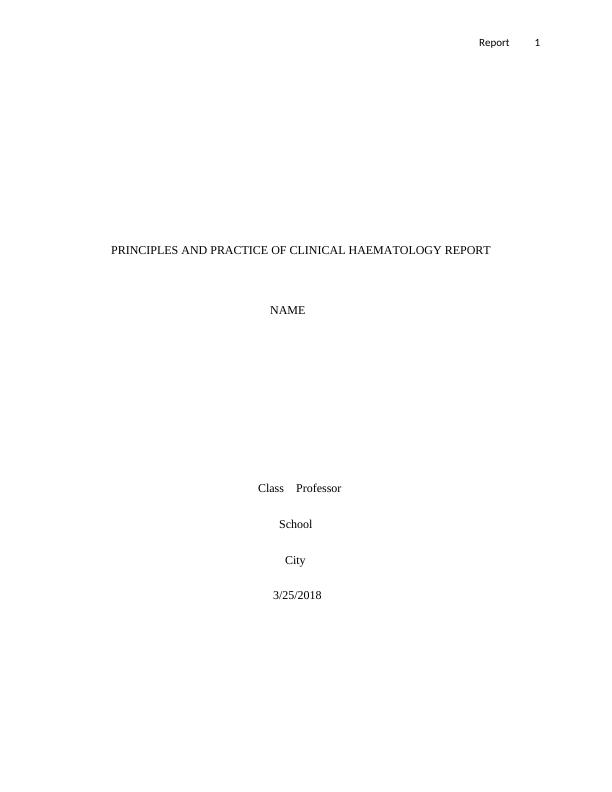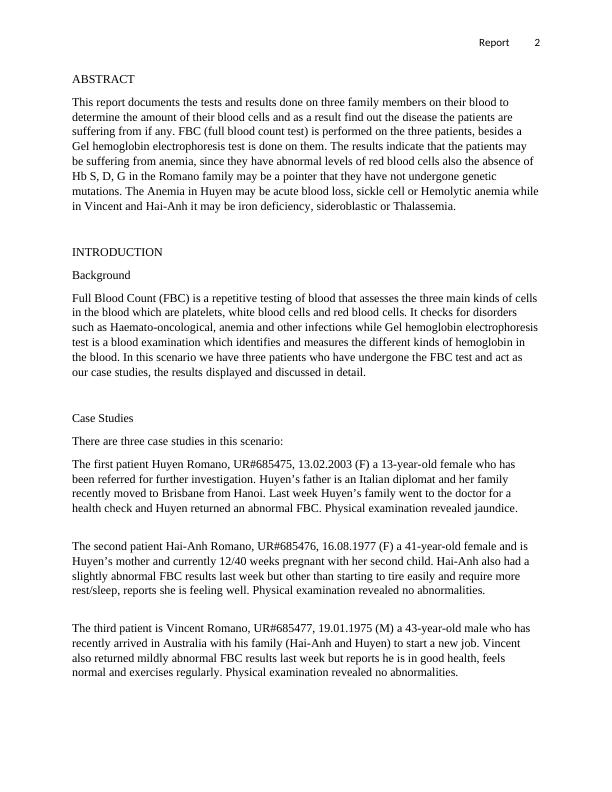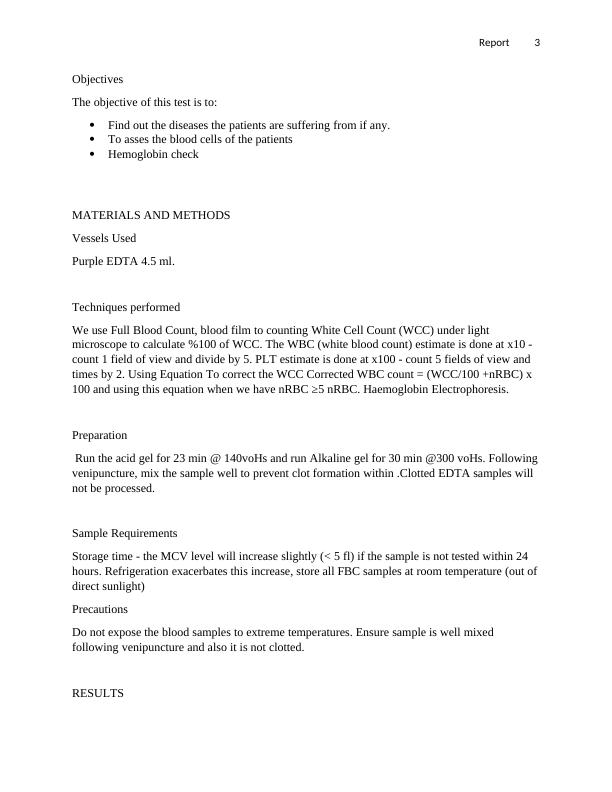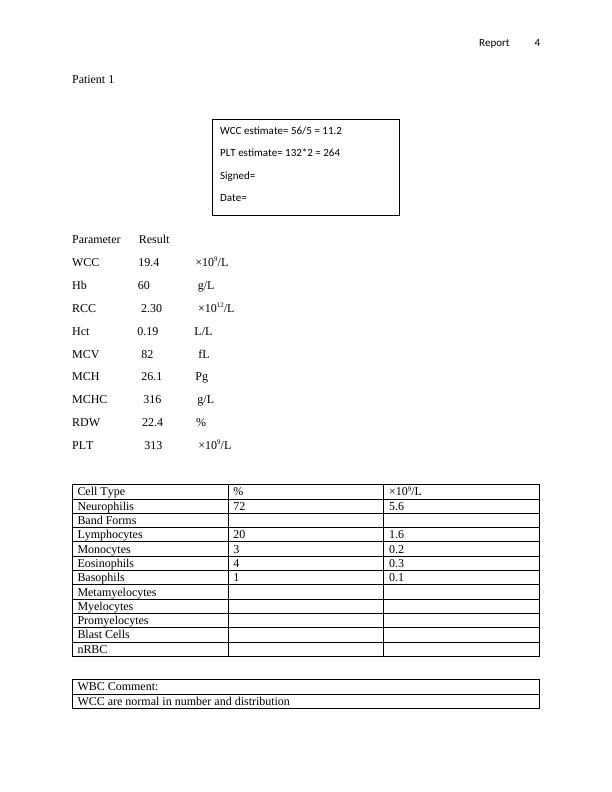Ask a question from expert
Introduction to hematology
16 Pages2730 Words200 Views
Added on 2021-04-24
Introduction to hematology
Added on 2021-04-24
BookmarkShareRelated Documents
Report 1 PRINCIPLES AND PRACTICE OF CLINICAL HAEMATOLOGY REPORT NAME Class Professor School City 3/25/2018

Report 2ABSTRACTThis report documents the tests and results done on three family members on their blood to determine the amount of their blood cells and as a result find out the disease the patients are suffering from if any. FBC (full blood count test) is performed on the three patients, besides a Gel hemoglobin electrophoresis test is done on them. The results indicate that the patients may be suffering from anemia, since they have abnormal levels of red blood cells also the absence of Hb S, D, G in the Romano family may be a pointer that they have not undergone genetic mutations. The Anemia in Huyen may be acute blood loss, sickle cell or Hemolytic anemia whilein Vincent and Hai-Anh it may be iron deficiency, sideroblastic or Thalassemia. INTRODUCTIONBackgroundFull Blood Count (FBC) is a repetitive testing of blood that assesses the three main kinds of cellsin the blood which are platelets, white blood cells and red blood cells. It checks for disorders such as Haemato-oncological, anemia and other infections while Gel hemoglobin electrophoresistest is a blood examination which identifies and measures the different kinds of hemoglobin in the blood. In this scenario we have three patients who have undergone the FBC test and act as our case studies, the results displayed and discussed in detail. Case StudiesThere are three case studies in this scenario:The first patient Huyen Romano, UR#685475, 13.02.2003 (F)a 13-year-old female who has been referred for further investigation.Huyen’s father is an Italian diplomat and her family recently moved to Brisbane from Hanoi.Last week Huyen’s family went to the doctor for a health check and Huyen returned anabnormal FBC. Physical examination revealed jaundice.The second patient Hai-Anh Romano, UR#685476, 16.08.1977 (F)a 41-year-old female and is Huyen’s mother and currently 12/40 weekspregnant with her second child. Hai-Anh also had a slightly abnormal FBC results last weekbut other than starting to tire easily and require more rest/sleep, reports she is feeling well.Physical examination revealed no abnormalities.The third patient is Vincent Romano, UR#685477, 19.01.1975 (M)a 43-year-old male who has recently arrived in Australia with his family(Hai-Anh and Huyen) to start a new job. Vincent also returned mildly abnormal FBC resultslast week but reports he is in good health, feels normal and exercises regularly. Physicalexamination revealed no abnormalities.

Report 3ObjectivesThe objective of this test is to:Find out the diseases the patients are suffering from if any.To asses the blood cells of the patients Hemoglobin checkMATERIALS AND METHODS Vessels UsedPurple EDTA 4.5 ml. Techniques performed We use Full Blood Count, blood film to counting White Cell Count (WCC) under light microscope to calculate %100 of WCC. The WBC (white blood count) estimate is done at x10 - count 1 field of view and divide by 5. PLT estimate is done at x100 - count 5 fields of view and times by 2. Using Equation To correct the WCC Corrected WBC count = (WCC/100 +nRBC) x 100 and using this equation when we have nRBC ≥5 nRBC. Haemoglobin Electrophoresis.Preparation Run the acid gel for 23 min @ 140voHs and run Alkaline gel for 30 min @300 voHs. Followingvenipuncture, mix the sample well to prevent clot formation within .Clotted EDTA samples will not be processed.Sample RequirementsStorage time - the MCV level will increase slightly (< 5 fl) if the sample is not tested within 24 hours. Refrigeration exacerbates this increase, store all FBC samples at room temperature (out ofdirect sunlight)Precautions Do not expose the blood samples to extreme temperatures. Ensure sample is well mixed following venipuncture and also it is not clotted. RESULTS

Report 4Patient 1Parameter ResultWCC 19.4 ×109/LHb 60 g/LRCC 2.30 ×1012/LHct 0.19 L/LMCV 82 fLMCH 26.1 PgMCHC 316 g/LRDW 22.4 %PLT 313 ×109/LCell Type%×109/LNeurophilis725.6Band Forms Lymphocytes 201.6Monocytes30.2Eosinophils40.3Basophils10.1MetamyelocytesMyelocytesPromyelocytesBlast Cells nRBCWBC Comment:WCC are normal in number and distributionWCC estimate= 56/5 = 11.2PLT estimate= 132*2 = 264Signed=Date=

End of preview
Want to access all the pages? Upload your documents or become a member.
Related Documents
ASSIGNMENT ON HEMATOLOGICAL COMPLAINS.lg...
|5
|765
|16
Diagnosis, Differential Diagnosis, Prognosis and Treatment of Chronic Lymphoblastic Leukemia (CLL)lg...
|7
|2333
|357
Diagnostic Clinical Microbiology: Two Cases of Endocarditis Caused by Streptococcus Pyogeneslg...
|8
|1646
|167